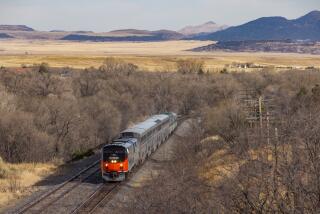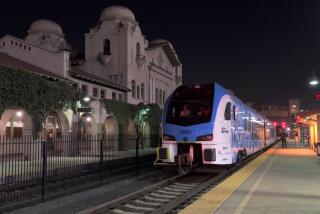On Track in the San Juan Mountains : Coloradoâs historic Durango & Silverton Railroad adds a winter run to its schedule.
Plumes of steam shot up like exclamation marks as the century-old locomotive huffed out of Durango to wend its way through Coloradoâs rugged San Juan Mountains.
The sky was squinting blue. Children waved from open-sided gondola cars; a party of adults in Victorian dress settled into an 1880s parlor car they had chartered for the Fourth of July.
And everyone within earshot--including those of us chattering outside The Quiet Lady saloon--paused to cheer.
The narrow-gauge train had a steep climb ahead. Silverton (population about 750)--the old gold-and-silver mining town at the northern end of the line--perches at 9,400 feet, almost 3,000 feet above Durango.
Twice along the spectacular wilderness route, the coal-fired train would stop for water. Twice it would stop near trail heads to drop off backpackers and fisherfolk.
From May until late October, âThe Silvertonâ makes four round trips a day, following the frothy Animas River through forested back country accessible only by rail, by horseback or on foot.
Cinders fly like tracers through the crystalline air.
There are many swifter trains in the world, and certainly many more quiet. But this jiggly, belching, honky-tonk ride warms the heart. Travelers crowd aboard to celebrate a scrappy remnant of the American frontier and to feast their eyes on a gorgeous chunk of southwestern Colorado.
With the coming of winter, however, a hush settles over the mountains. Snow tires are put on four-wheel-drive vans; skis are readied for the nearby slopes, such as Purgatory. Train service to Silverton is suspended.
But this year--for the first time since 1986--a holiday excursion is scheduled. From Nov. 25 through Dec. 31--except for Christmas Eve and Day--the little train will make a daily, 52-mile round trip to Cascade Canyon, about halfway to Silverton.
Amos Cordova, a spokesman for the Durango & Silverton Railroad, told me that the train--with probably eight to 10 cars--will stop at noon for an hour so that passengers can play in the snow. Three- to four-foot drifts are common at Cascade Canyon, he said.
Cameras and binoculars add to the pleasure. In the white of winter--with birch and aspen groves stripped of their leaves--it is easier to see deer and elk, hawks and eagles and beaver.
The Alamosa parlor car, built in 1880, will bring up the rear of the winter train. With its fancy ashwood bar and genial bartender, this coach is available for private parties and wedding receptions.
Capacity for the parlor car is 28 adults (21 is the minimum age).
In any season, Durango smacks of the Old West. Along the wide main street--stubbornly named Main Avenue--red-brick and native-stone buildings are mostly two stories tall.
All roads lead to the yellow-frame depot, which, considering local history, seems only fair. The town of Durango was founded in 1879 by a railroad company--the Denver & Rio Grande--as its base for building the tough, narrow-gauge line to haul the rich ore from Silverton.
If you go: The Winter Train departs Durango for Cascade Canyon at 10 a.m. daily, Nov. 25 through Dec. 31 (except Dec. 24-25), returning at 3 p.m. Round-trip fares are $31.45 for adults, $15.70 for children 5-11, free for those under 5. For the adults-only parlor car, the fare is $52.50.
For reservations, call or write: Durango & Silverton Narrow Gauge Railroad, 479 Main Ave., Durango, Colo. 81301, (303) 247-2733. Service from Durango to Silverton (90 miles round trip) will resume May 1.
More to Read
Sign up for The Wild
Weâll help you find the best places to hike, bike and run, as well as the perfect silent spots for meditation and yoga.
You may occasionally receive promotional content from the Los Angeles Times.






